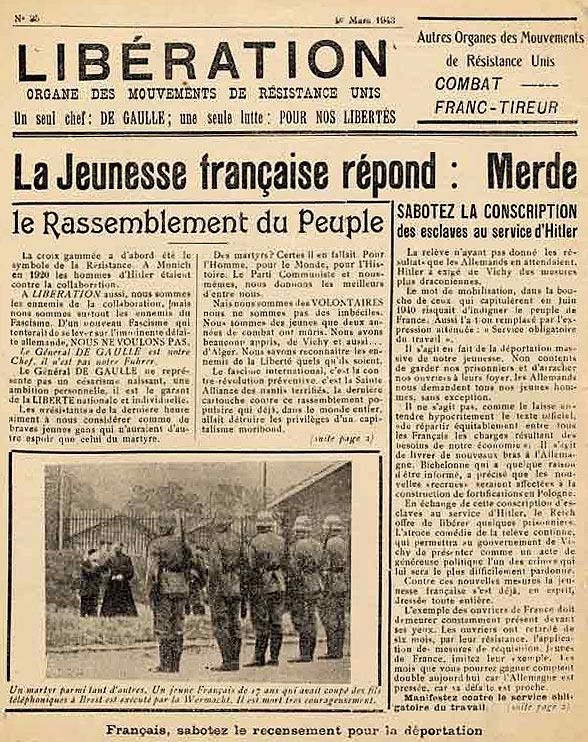The maquis

The expression prendre le maquis, meaning to join one of the armed guerrilla groups that took refuge in the French countryside, first appeared in late 1942. The development of the maquis is indissociable from the implementation of Compulsory Labour Service (STO), at the insistence of Fritz Sauckel, which was introduced by the law of 16 February 1943, replacing that of 4 September 1942, which had provided for the potential mobilisation of men aged 21 to 35. Prompting a strong reaction from the population, the promulgation of the STO and the call-ups and roundups that followed were quickly denounced by a flourishing underground press. On 1 March 1943, Libération had as its front-page headline “French youth replies: Go to hell!” and called on its readers to: “Sabotage the conscription of slaves for Hitler. [...] It amounts to the mass deportation of our youth.” Those who avoided the STO were often protected by friends or family willing to put them up. At least 10% of these “STO dodgers”, possibly more, agreed to become maquisards, mostly out of patriotic instinct.
The Resistance soon saw how they could take on these conscientious objectors, who could swell their ranks. But they had to be provided with false papers, hiding-places, provisions and training. Therefore, in March 1943, the leaders of the Mouvements Unis de Résistance (MUR) asked for financial aid and material support from London, through the intermediary of Jean Moulin and Charles Delestraint, commander-in-chief of the Armée Secrète (AS). But for the British, the question of immediate action, and that included arming the maquis, was by no means a priority. As a result, the maquis would receive inadequate weapons drops until spring 1944.
With the development of the maquis, the armed Resistance grew in size as thousands of objectors joined their ranks. It also affirmed its legitimacy among the population. By the spring of 1944, it is likely that the maquisards numbered scarcely more than 50 000, mainly concentrated in hilly areas (Auvergne, Limousin, Ain and Jura, Morvan, Vercors, Oisans, the Southern Alps). Rather than high mountains, the maquis chose inhabited hilly areas, where their camps could be set up a good distance apart: sufficiently close to villages and hamlets to obtain provisions, yet sufficiently far away to preserve the necessary discretion and the possibility of escape.
Relatively few in number, and in any event poorly armed, the maquisards were nevertheless increasingly well trained, due to the arrival of officers and NCOs from the former Armistice Army. They prepared for the landings, which all hoped would be imminent. All over the country, “civilian companies” and “standby” groups were set up to provide reinforcements when the time came.

The front page of edition no 25 of the newspaper Libération, dated 1 March 1943. Copyright private collection.

